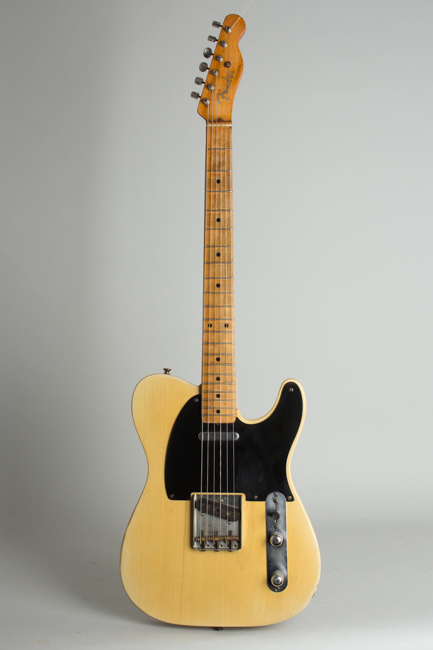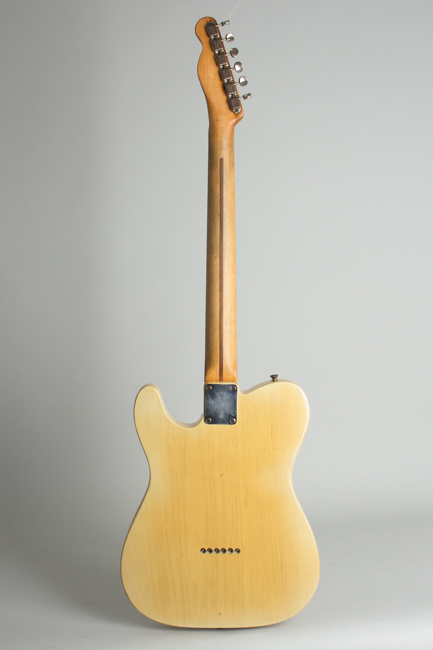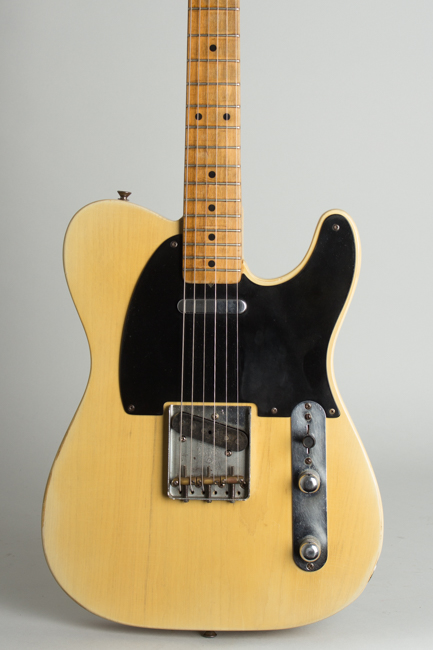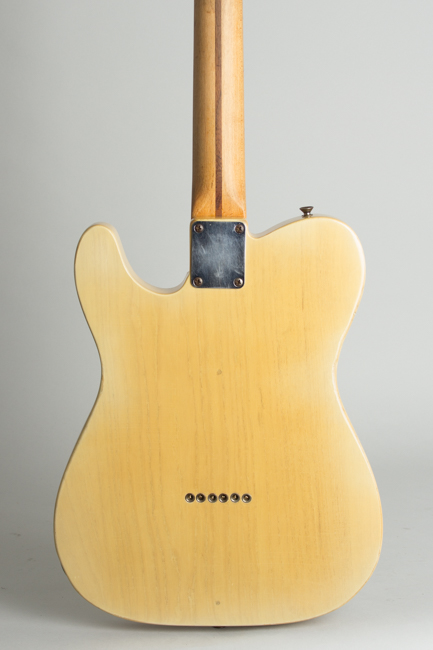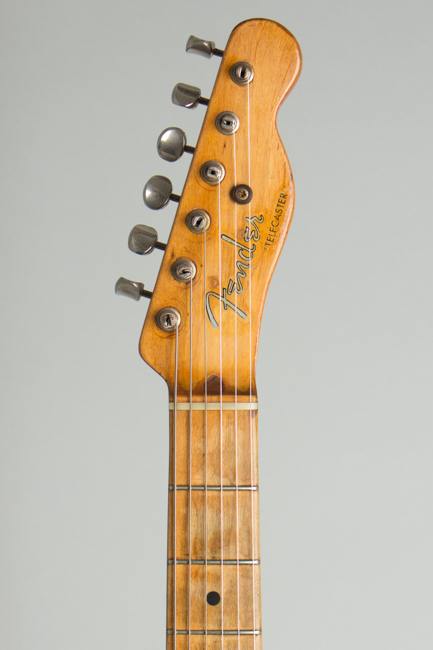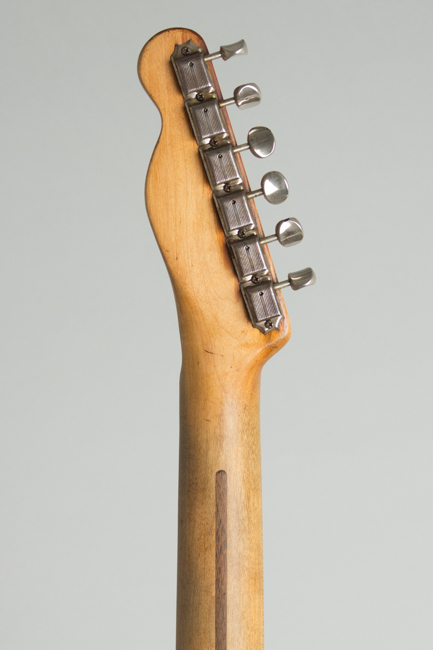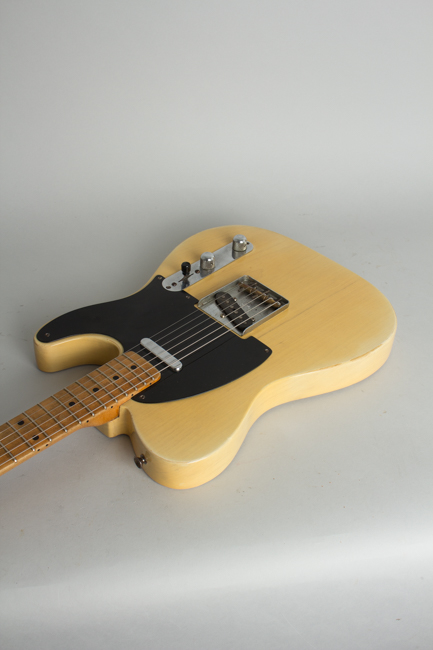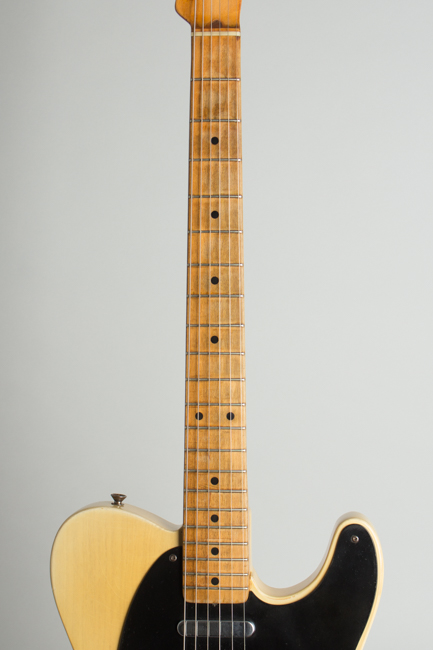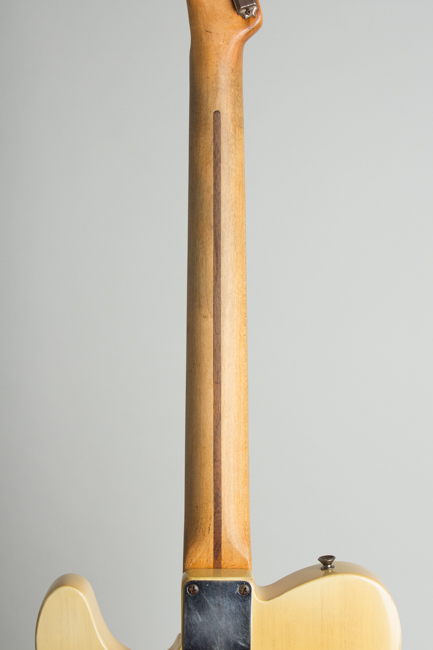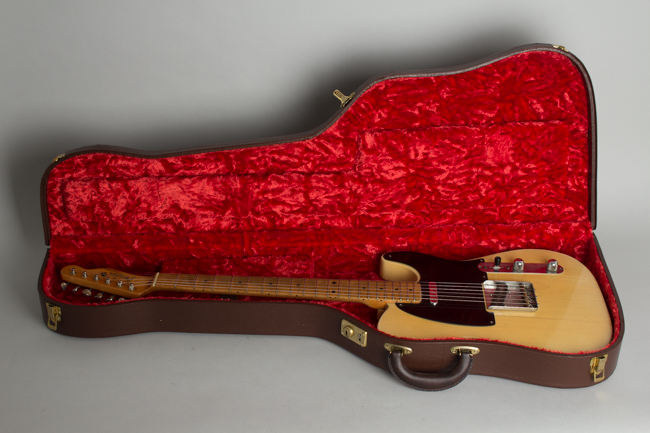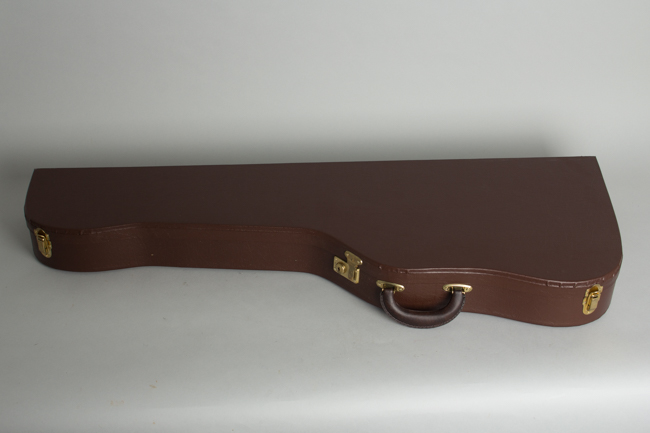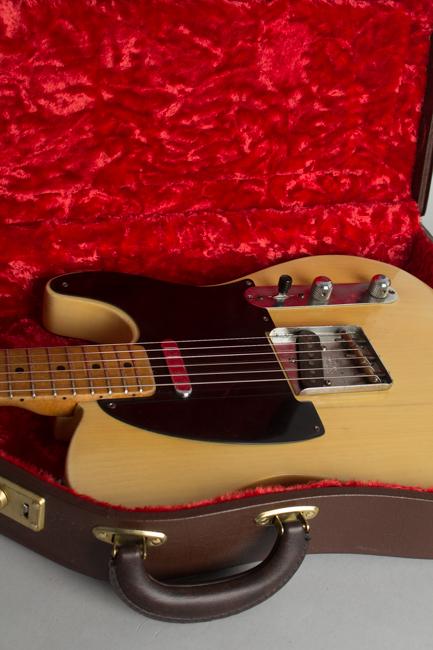Fender Telecaster Solid Body Electric Guitar (1953)
This item has been sold.
Item # 9418
Prices subject to change without notice.
Fender Telecaster Model Solid Body Electric Guitar (1953), made in Fullerton, California, serial # 5176, Blonde lacquer re- finish, ash body, maple neck, brown hard shell case.
This 1953 "Blackguard" Fender Telecaster has had an eventful life over the last nearly 70 years but has been beautifully restored by a true master. It was long ago stripped down to natural but now has a beautiful "light relic" Blonde restoration refinish on the body by J. Black, former Fender Custom Shop Master Builder and one of the world's foremost experts on the care and healing of old Fenders. The neck has had an overspray removed and is now in a polished satin finish with some remnants of the original yellowed lacquer visible. All work has been done to the highest standard, and this is a beautiful-looking and fantastic playing and sounding Telecaster.
This guitar was originally assembled at the company's Fullerton, California factory in mid-1953. Telecasters from this year retain all the classic '52 features: the one-piece maple neck, aged "butterscotch" blonde-finished ash body, lacquered black fiber pickguard, brass bridge saddles, and of course the original black-bobbin hand wound pickups with a sound for the ages! This guitar carries a very consistent set of date markings and the serial number 5176 stamped on the bridgeplate.
The neck is marked 6-5-53 in pencil on the heel, which was partially lost when the neck was refinished long ago but is still just about legible. The body carries a very clear penciled date 6-1-53 in the neck cavity, with the initials "EM" (Eddie Miller) beside. The potentiometer codes are 140-218 indicating the pieces were made the 18th week of 1952. Gloria wired this guitar up on 6-8-53 and left her masking tape signature in the control cavity, as she did on many other original Telecasters.
The pickups and electronics are original. The only alteration is it has been wired to the "modern" Telecaster switching scheme to allow for more playing flexibility. The complete original rig (pots, caps, and switch) are intact except for the "Mud Cap" that provided the so-called "deep bass" setting. This alteration is very common in Telecasters of this period, as they were originally wired with the bass capacitor engaged in position #1 with no pickup blend setting available.
The neck is moderately slim for a '53 and round backed. All screws are original and Phillips-head type as is customary for 1953. The '53 Telecaster still has the same look and feel of the earliest Fender guitars from 1950-51, although many of the fine details gradually evolved as the decade went along. This particular year is considered by many Fender aficionados as the peak of the company's early period and the apex of quality and consistency for their first Spanish guitar, before the introduction of the second Fender solid-body, the Stratocaster.
Fender Telecasters of this period are considered one of the most collectable and historic of all electric guitars, and some rank the 1953 Telecasters to be among the most desirable example of the model. Many artists most associated with "blackguard" Teles have used examples from this year including Roy Buchanan, Danny Gatton, James Burton, Keith Richards, Albert Lee, and Red Volkaert. The "butterscotch" blonde ash body and maple neck are subtly changed from the earlier examples, with the neck profile being slightly sleeker than "Broadcaster" standards. In his authoritative and beautiful book "The Blackguard", author Nachos Banos references this and states "There is something really magical about these mid-'53s".
Overall length is 38 3/4 in. (98.4 cm.), 12 5/8 in. (32.1 cm.) wide at lower bout, and 1 3/4 in. (4.4 cm.) in depth, measured at side of rim. Scale length is 25 1/2 in. (648 mm.). Width of nut is 1 5/8 in. (41 mm.).
This guitar has had major restoration at the hands of J. Black, which he documented thoroughly and helpfully detailed for us as follows:
"This 1953 Fender Telecaster was purchased from Bentley Music in Missouri. It was hippie wood natural when I bought it to restore. Only the case and pickguard were missing. The neck has its original tuners, string tree, and decal. I refretted the guitar with vintage style frets, the original frets are included. The neck had a paint brush overspray on the original finish. I removed as much I could, so the neck has a little original finish, some older paint brush finish and I did some overspray to protect what was left of the date on the end of the neck. The date was partially there, I assume it was 6-5-53 originally.
The neck had a small chip out of the maple behind the nut on the bass side that I repaired. The neck also had 2 extra string trees (for a total of three, the holes are plugged, but visible). The neck shape is a friendly early '50s soft shoulder version .885 at the 1st fret deep and .975 at the 12th fret.
The body was intact, no routes, only "hippie wood" refinished. The body has the original date, EM initial 6-1-53 date and a tape date in the control cavity, signed by Gloria 6-8-53. The neck and bridge pickups are original to the instrument. The bridge pickup sounds great, it's why you own a blackguard. It's wired for modern wiring, but has the original pots, switch, switch tip, output jack and capacitor. The pickguard is a reissue. The bridge has a repaired hole that someone drilled through the bridge and into the rear pickup cavity. Best guess, they screwed the ash tray cover onto the bridge into the body! The original height adjust screws are very tall and palm eaters, so it has reissue height adjust screws but the originals are in the case, along with the original frets."
We would add that there are compression rings on the face of the headstock indicating other tuners were fitted at some point. The plated parts show some wear and the finish is lightly reliced so the whole guitar has a great look to it. The reissue pickguard looks quite good, better than most we have seen.
This is a lovely example of a thoughtfully restored Blackguard, some of the most desirable of all vintage electrics today. This one plays effortlessly and sounds fantastic, exactly as it should. The package includes a nice reissue flat-bottom "poodle" case and a CD with some interesting "before and after" photos of the finish and components. Restored to Excellent Condition.
This 1953 "Blackguard" Fender Telecaster has had an eventful life over the last nearly 70 years but has been beautifully restored by a true master. It was long ago stripped down to natural but now has a beautiful "light relic" Blonde restoration refinish on the body by J. Black, former Fender Custom Shop Master Builder and one of the world's foremost experts on the care and healing of old Fenders. The neck has had an overspray removed and is now in a polished satin finish with some remnants of the original yellowed lacquer visible. All work has been done to the highest standard, and this is a beautiful-looking and fantastic playing and sounding Telecaster.
This guitar was originally assembled at the company's Fullerton, California factory in mid-1953. Telecasters from this year retain all the classic '52 features: the one-piece maple neck, aged "butterscotch" blonde-finished ash body, lacquered black fiber pickguard, brass bridge saddles, and of course the original black-bobbin hand wound pickups with a sound for the ages! This guitar carries a very consistent set of date markings and the serial number 5176 stamped on the bridgeplate.
The neck is marked 6-5-53 in pencil on the heel, which was partially lost when the neck was refinished long ago but is still just about legible. The body carries a very clear penciled date 6-1-53 in the neck cavity, with the initials "EM" (Eddie Miller) beside. The potentiometer codes are 140-218 indicating the pieces were made the 18th week of 1952. Gloria wired this guitar up on 6-8-53 and left her masking tape signature in the control cavity, as she did on many other original Telecasters.
The pickups and electronics are original. The only alteration is it has been wired to the "modern" Telecaster switching scheme to allow for more playing flexibility. The complete original rig (pots, caps, and switch) are intact except for the "Mud Cap" that provided the so-called "deep bass" setting. This alteration is very common in Telecasters of this period, as they were originally wired with the bass capacitor engaged in position #1 with no pickup blend setting available.
The neck is moderately slim for a '53 and round backed. All screws are original and Phillips-head type as is customary for 1953. The '53 Telecaster still has the same look and feel of the earliest Fender guitars from 1950-51, although many of the fine details gradually evolved as the decade went along. This particular year is considered by many Fender aficionados as the peak of the company's early period and the apex of quality and consistency for their first Spanish guitar, before the introduction of the second Fender solid-body, the Stratocaster.
Fender Telecasters of this period are considered one of the most collectable and historic of all electric guitars, and some rank the 1953 Telecasters to be among the most desirable example of the model. Many artists most associated with "blackguard" Teles have used examples from this year including Roy Buchanan, Danny Gatton, James Burton, Keith Richards, Albert Lee, and Red Volkaert. The "butterscotch" blonde ash body and maple neck are subtly changed from the earlier examples, with the neck profile being slightly sleeker than "Broadcaster" standards. In his authoritative and beautiful book "The Blackguard", author Nachos Banos references this and states "There is something really magical about these mid-'53s".
Overall length is 38 3/4 in. (98.4 cm.), 12 5/8 in. (32.1 cm.) wide at lower bout, and 1 3/4 in. (4.4 cm.) in depth, measured at side of rim. Scale length is 25 1/2 in. (648 mm.). Width of nut is 1 5/8 in. (41 mm.).
This guitar has had major restoration at the hands of J. Black, which he documented thoroughly and helpfully detailed for us as follows:
"This 1953 Fender Telecaster was purchased from Bentley Music in Missouri. It was hippie wood natural when I bought it to restore. Only the case and pickguard were missing. The neck has its original tuners, string tree, and decal. I refretted the guitar with vintage style frets, the original frets are included. The neck had a paint brush overspray on the original finish. I removed as much I could, so the neck has a little original finish, some older paint brush finish and I did some overspray to protect what was left of the date on the end of the neck. The date was partially there, I assume it was 6-5-53 originally.
The neck had a small chip out of the maple behind the nut on the bass side that I repaired. The neck also had 2 extra string trees (for a total of three, the holes are plugged, but visible). The neck shape is a friendly early '50s soft shoulder version .885 at the 1st fret deep and .975 at the 12th fret.
The body was intact, no routes, only "hippie wood" refinished. The body has the original date, EM initial 6-1-53 date and a tape date in the control cavity, signed by Gloria 6-8-53. The neck and bridge pickups are original to the instrument. The bridge pickup sounds great, it's why you own a blackguard. It's wired for modern wiring, but has the original pots, switch, switch tip, output jack and capacitor. The pickguard is a reissue. The bridge has a repaired hole that someone drilled through the bridge and into the rear pickup cavity. Best guess, they screwed the ash tray cover onto the bridge into the body! The original height adjust screws are very tall and palm eaters, so it has reissue height adjust screws but the originals are in the case, along with the original frets."
We would add that there are compression rings on the face of the headstock indicating other tuners were fitted at some point. The plated parts show some wear and the finish is lightly reliced so the whole guitar has a great look to it. The reissue pickguard looks quite good, better than most we have seen.
This is a lovely example of a thoughtfully restored Blackguard, some of the most desirable of all vintage electrics today. This one plays effortlessly and sounds fantastic, exactly as it should. The package includes a nice reissue flat-bottom "poodle" case and a CD with some interesting "before and after" photos of the finish and components. Restored to Excellent Condition.
